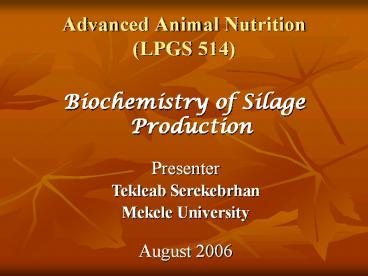Biochemistry of Silage Production - PowerPoint PPT Presentation
Title:
Biochemistry of Silage Production
Description:
describes the biochemistry of silage preparation – PowerPoint PPT presentation
Number of Views:183
Title: Biochemistry of Silage Production
1
Advanced Animal Nutrition (LPGS 514)
Biochemistry of Silage Production
Presenter Tekleab Serekebrhan Mekele University
August 2006
2
1. Introduction
Silage
- Silage It is a biochemical process product of
both the plant and microbial activities and
their effect on the plant material by achieving
anaerobic condition. - Moist feed made by the transformation of plant
materials to a preserved fodder through anaerobic
condition - It has been used since 18th century in Sweden
3
Introduction Conti.
- Advantage
- Intensification of forage production
- Less risk associated with weather conditions
- reduced loss of leaves and other small plant
parts of high quality in the field - Disadvantage
- requires high capital investment
- no off farm market opportunity
4
Introduction Conti.
Objective
- - To show who the biochemistry of silage
production takes place.
Method
- - referring books, Literatures, internet,
personal experience
5
Discussion
- The biochemistry of Silage production involves
any activities or reactions which takes place and
results alteration in the chemical and physical
status of the ensiled plant material - The two main components in the biochemical
process of silage production - 1.The plant species and stages of harvest
- 2.The chemical change or reactions resulting from
the activities of plant enzyme and microbes - (Core of paper)
6
Discussion Cont.
- Plant enzymes
- These acts on plant tissue just after cutting and
during the earlier stage in silo undergoes - Respiration (oxidative degradation of organic
compound to yield energy) glycolysis, oxidation
(TCA) - sugar oxygen ? carbon dioxide water heat
- Proteolysis Once the material ensiled degrade
protein to peptides and amino acids and decline
as the pH falls.
7
Discussion cont.
- Microorganisms
- fresh herbage - Aerobic fungi and bacteria
- --- as anaerobic condition develop in the silo
they are replaced by anaerobic bacteria, able to
grow in the absence of oxygen (Mc Donald et al,
1995) - Fermentation
8
Discussion cont. Fermentation Processes
- Silage fermentation is a biological process
whereby bacteria are responsible to convert WSC
to organic acids including LA, AA, ethanol,
mannitol and CO2.
- Phases are classified based on
- the microbes involved in the process
- 4 phases 2undisirable
- absence or presence of oxygen in the chemical
process. - 2 phases
9
based on the type of microbe involved
the Process
- Phase 1-Respiration
- C6H12O6 6 O2 ------gt 6 CO2 6 H2O 3.8
Mcal/kg sugar - oxygen is reduced and NADH2 is oxidized
- Phase 2 Early fermentation (enterobacteria)
- water soluble ---? into acetate, ethanol,
hydrogen and CO2. - Deaminate amino acids which result in decrease
palatability. - Phase 3 Lactic acid fermentation
(homofermentatives LAB pyruvate (Glycolysis)
?LA - organic compound is reduced and NADH2 is oxidized
- free sugars ? lactic acid lowering pH
- Phase 4 Stabilization phase (LAB)
- low pH created in phase 3 stops plant enzymatic
activity and further microbial metabolism
degradation
chemical pathway of lactic acid (diagram)
10
the Process
respiration
fermentation
Deterioration
11
the processUndesirable phases
Two other undesirable phases can also take place
and cause important loss of dry matter and forage
quality in a silo
- 1. Butyric acid fermentation by clostridia (BAB)
- ( if phase 3 (LAF) is fail to achieve low pH in
phase 4) - 2) Aerobic deterioration caused by molds and
yeast- just after O2 exposure
12
Other factors
- Plant maturity and moisture content
- optimum 50-65 moisture before it is put in silo
- If low moisture - restricted fermentations,
thereby producing less stable silages that have
lower lactic acid concentrations and are less
acidic - If high moisture - effluent
- - clostridial fermentations
- Proper maturity ? adequate fermentable sugars for
silage bacteria and maximum nutritional value for
livestock
13
Other factors cont.
- Nature of the plant
- Legumes they have high protein content.
- Problems
- low content of sugars,
- high buffering capacity (resist pH changes)
- high moisture content.
- Recommended type
- Carbohydrate rich crops that contain more than
two part of carbohydrate to one part of protein.
14
Other factors cont.
- Silage additives
- Promote high levels of lactic acid production and
create a low pH (3.8-4.2). - (1) inoculants ensure adequate quantities of
lactic acid-producing bacteria (mostly bacteria) - (2) enzymes (release additional sugar fiber
deg.) - (3) substrate sources primarily sugars, such as
molasses, glucose, sucrose and dextrose - 4) inhibitors inhibiting the fermentation
process and growth of all microbes in the silo
(formic acid)
15
Fermentation guide smell and texture (Physical
Assessment)
- Good Yellow or brown-green ,Sweet acid
smell, Firm texture - Overheated Dark, brown-black Burnt caramel-
tobacco smell, Dry, disintegrated texture - Butyric Olive green, Evil putrid smell ,Soft and
slimy - Moldy Dark brown with white mould, Musty smell
Dry, easily broken texture - Putrid/rotted Green/ black, Putrid smell, Wet,
slimy
16
Conclusion
- Chemical changes are the result of plant enzymes
activity (respiration and proteolysis) and action
of microbes depending on the absence or presence
of oxygen. - The quality of silage is more dependant on the
quality of plant material they used - Factors necessary for good fermentation of
silage - anaerobic conditions (no O2 air)
- proper moisture
- sufficient plant water-soluble carbohydrates or
sugars - proper bacteria
17
Tip
Dairy cattle feed on silage, www.oznet.ksu.edu/pr_
silage A Trouble-\ Shooter For Common Silage
Problems
18
Thank you

